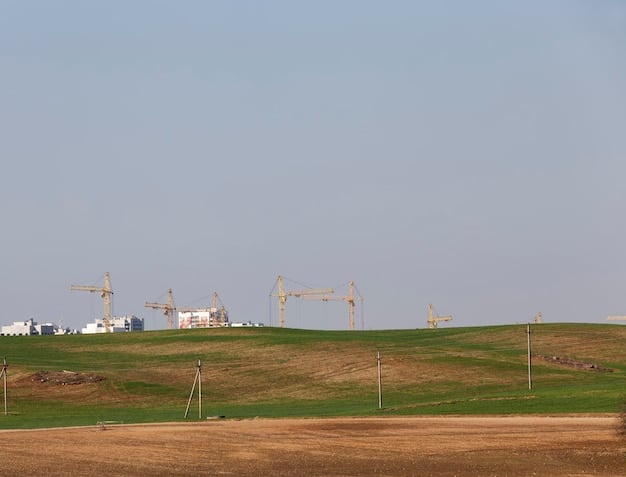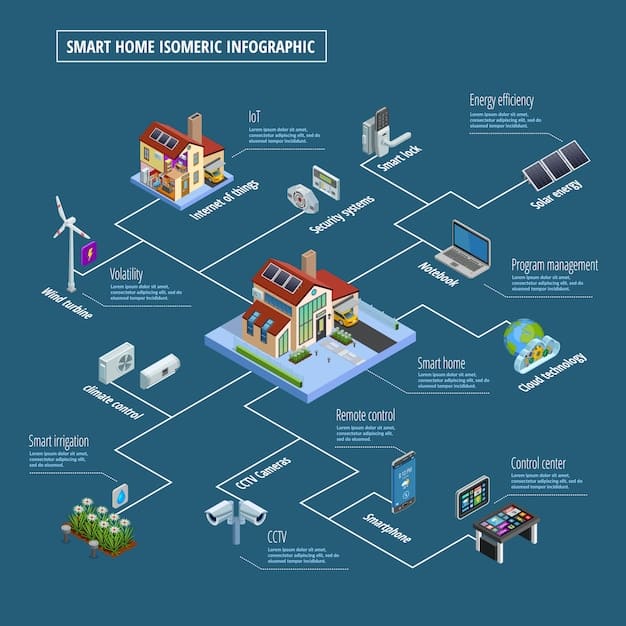Renewable Energy Surge: How 15% Growth Impacts US Grid Stability

The projected 15% increase in US renewable energy capacity by 2025 is poised to significantly impact grid stability by introducing variability and requiring advanced grid management solutions to ensure a reliable and resilient power supply across the nation.
As the US strides towards a greener future, the anticipated 15% surge in renewable energy capacity by 2025 sparks a crucial question: How Will the Projected 15% Increase in US Renewable Energy Capacity by 2025 Impact Grid Stability?
Understanding the Renewable Energy Expansion in the US
The United States is witnessing a significant push towards renewable energy sources, driven by environmental concerns, economic opportunities, and technological advancements. This expansion includes solar, wind, hydro, and geothermal power, each contributing to a more diversified energy portfolio. The projected 15% increase represents a substantial leap, poised to reshape the nation’s energy landscape.
Factors Driving Renewable Energy Growth
Several factors contribute to this surge in renewable energy capacity. Government incentives, such as tax credits and renewable portfolio standards, encourage investment in clean energy projects. Declining costs of solar and wind technologies make them increasingly competitive with traditional fossil fuels. Furthermore, growing public awareness and corporate sustainability initiatives are driving demand for renewable energy solutions.
- Government policies and incentives boost renewable investments.
- Decreasing technology costs enhance competitiveness.
- Public and corporate demand accelerates adoption.
The increasing adoption of renewable energy sources is not merely a trend; it’s a strategic move to enhance energy security, reduce carbon emissions, and foster sustainable economic growth. As more states and businesses commit to renewable energy targets, the pace of this transition is expected to accelerate further.

In conclusion, the expansion of renewable energy in the US is driven by a confluence of factors, including policy support, technological advancements, and growing demand. This transition presents both opportunities and challenges that need to be addressed to ensure a stable and reliable energy grid.
The Fundamentals of Grid Stability
Grid stability refers to the ability of an electrical grid to maintain a steady and reliable flow of electricity. A stable grid ensures that power supply meets demand at all times, preventing blackouts and other disruptions. Achieving this stability requires careful management of various factors, including voltage, frequency, and reactive power.
The traditional grid relies on centralized power plants, such as coal and nuclear, which provide a constant and predictable supply of electricity. However, the integration of renewable energy sources introduces new challenges due to their intermittent nature. Solar and wind power, for example, depend on weather conditions, making their output variable and less predictable.
Key Challenges to Grid Stability
Integrating renewable energy sources into the grid poses several challenges. One of the primary concerns is the variability of renewable generation. Solar and wind power fluctuate depending on sunlight and wind speed, making it difficult to match supply with demand. This variability can lead to voltage and frequency fluctuations, potentially destabilizing the grid.
- Variability of renewable generation (solar, wind).
- Need for advanced forecasting and grid management.
- Balancing supply and demand in real-time.
Another challenge is the geographical distribution of renewable energy resources. Solar and wind farms are often located in remote areas, far from population centers where electricity demand is highest. This requires long-distance transmission lines, which can be costly and subject to transmission losses.
In summary, grid stability is paramount for ensuring a reliable electricity supply. The integration of intermittent renewable energy sources presents significant challenges that require innovative solutions and advanced grid management strategies.
Impact of Renewable Energy on Grid Frequency
Grid frequency, typically around 60 Hz in the US, is a critical indicator of grid stability. Fluctuations in frequency can signal an imbalance between power supply and demand, potentially leading to grid instability and blackouts. Renewable energy sources, due to their variability, can introduce frequency fluctuations that need to be carefully managed.
Traditional power plants, such as coal and nuclear, provide inertia to the grid. Inertia is the ability of rotating generators to resist changes in frequency. When demand increases suddenly, the inertia of these generators helps to maintain a stable frequency. Renewable energy sources, particularly solar and wind, do not inherently provide inertia, which can exacerbate frequency fluctuations.
Mitigating Frequency Fluctuations
Several strategies can be employed to mitigate frequency fluctuations caused by renewable energy. Advanced forecasting techniques can help predict the output of solar and wind farms, allowing grid operators to anticipate and respond to changes in supply. Fast-response technologies, such as battery energy storage systems, can quickly inject or absorb power to stabilize frequency.
- Advanced forecasting for renewable output.
- Fast-response energy storage systems.
- Enhanced grid monitoring and control systems.
Furthermore, grid-forming inverters can be used to mimic the behavior of traditional generators, providing synthetic inertia to the grid. These inverters can actively regulate voltage and frequency, contributing to grid stability. Smart grid technologies, such as advanced metering infrastructure and real-time monitoring systems, also play a crucial role in maintaining frequency stability.
In conclusion, while renewable energy sources can introduce frequency fluctuations, various mitigation strategies are available. These strategies include advanced forecasting, energy storage, grid-forming inverters, and smart grid technologies, all of which contribute to maintaining grid frequency stability.

Voltage Control and Renewable Integration
Voltage control is another essential aspect of grid stability. Maintaining voltage within acceptable limits ensures that electrical equipment operates efficiently and prevents damage. Renewable energy sources, particularly solar and wind, can impact voltage levels due to their variable output and distributed nature.
Solar and wind farms can cause voltage fluctuations, especially at the points where they connect to the grid. During periods of high renewable generation, voltage can rise above acceptable levels. Conversely, during periods of low generation, voltage can drop. These fluctuations can affect the performance of electrical equipment and potentially lead to grid instability.
Strategies for Voltage Control
Several strategies can be implemented to manage voltage fluctuations caused by renewable energy. Reactive power compensation devices, such as capacitor banks and static VAR compensators, can be used to regulate voltage levels. These devices inject or absorb reactive power to maintain voltage within acceptable limits. Smart inverters, which are equipped with advanced control capabilities, can also play a crucial role in voltage control.
- Reactive power compensation devices (capacitor banks).
- Smart inverters with advanced control capabilities.
- Coordinated voltage control strategies.
Furthermore, coordinated voltage control strategies, which involve coordinating the operation of multiple voltage control devices, can improve voltage stability across the grid. These strategies rely on advanced monitoring and control systems that provide real-time information about voltage levels throughout the grid. By implementing these strategies, grid operators can effectively manage voltage fluctuations and ensure grid stability.
In summary, voltage control is critical for maintaining grid stability in the presence of renewable energy. Strategies such as reactive power compensation, smart inverters, and coordinated voltage control can effectively manage voltage fluctuations and ensure reliable grid operation.
The Role of Energy Storage in Grid Stability
Energy storage systems, such as batteries, pumped hydro, and compressed air energy storage, are increasingly recognized as essential components of a modern and stable grid. These systems can store excess electricity generated from renewable sources and release it when demand is high or when renewable generation is low. Energy storage helps to smooth out the intermittency of renewable energy, providing a more reliable and predictable power supply. As How Will the Projected 15% Increase in US Renewable Energy Capacity by 2025 Impact Grid Stability?, it is essential to consider energy storage systems.
Energy storage systems can provide a variety of grid services, including frequency regulation, voltage support, and peak shaving. Frequency regulation involves quickly injecting or absorbing power to maintain grid frequency within acceptable limits. Voltage support involves regulating voltage levels to prevent fluctuations and ensure stable grid operation. Peak shaving involves reducing electricity demand during peak hours, which can alleviate stress on the grid and lower electricity costs.
Benefits of Energy Storage
The benefits of energy storage extend beyond grid stability. Energy storage can also improve the utilization of renewable energy resources, reduce transmission congestion, and enhance grid resilience. By storing excess renewable energy, energy storage systems can prevent curtailment, which is the wasting of renewable energy due to grid constraints. Energy storage can also reduce the need for expensive grid upgrades by alleviating transmission congestion. Furthermore, energy storage can enhance grid resilience by providing backup power during outages and extreme weather events.
- Improves utilization of renewable energy resources.
- Reduces transmission congestion and lowers costs.
- Enhances grid resilience during outages.
The deployment of energy storage systems is growing rapidly, driven by declining costs and increasing recognition of their value. As more energy storage projects come online, the grid will become more flexible, reliable, and resilient. Energy storage is a key enabler of a sustainable energy future.
In conclusion, energy storage plays a crucial role in maintaining grid stability in the presence of renewable energy. By providing a variety of grid services and enhancing grid resilience, energy storage is essential for a modern and sustainable energy future.
Advanced Grid Management Technologies
Advanced grid management technologies are essential for integrating large amounts of renewable energy into the grid while maintaining stability. These technologies include advanced forecasting systems, smart grid technologies, and advanced control algorithms.
Advanced forecasting systems use weather models, machine learning, and real-time data to predict the output of renewable energy sources. These forecasts allow grid operators to anticipate changes in supply and adjust grid operations accordingly. Smart grid technologies, such as advanced metering infrastructure and real-time monitoring systems, provide grid operators with detailed information about grid conditions. This information enables them to make informed decisions and respond quickly to changing conditions.
The Importance of Real-Time Data
Advanced control algorithms use real-time data and forecasts to optimize grid operations. These algorithms can automatically adjust voltage levels, frequency, and power flows to maintain grid stability. They can also coordinate the operation of multiple grid devices, such as generators, energy storage systems, and reactive power compensation devices.
- Improved forecasting of renewable energy output.
- Enhanced grid monitoring and control systems.
- Automated grid optimization algorithms.
These technologies are enabling grid operators to manage the complexities of integrating large amounts of renewable energy into the grid. As renewable energy deployment continues to increase, advanced grid management technologies will become even more important for maintaining grid stability and reliability.
In summary, advanced grid management technologies play a critical role in integrating renewable energy into the grid. By providing improved forecasting, enhanced monitoring and control, and automated optimization, these technologies are essential for maintaining grid stability and reliability.
| Key Point | Brief Description |
|---|---|
| ⚡ Renewable Expansion | US aims for a 15% increase in renewable energy by 2025. |
| 🔄 Grid Stability | Ensuring reliable electricity flow amidst renewable integration. |
| 🔋 Energy Storage | Batteries smooth renewable intermittency and enhance reliability. |
| 💡 Grid Management | Advanced technologies optimize grid operations with renewables. |
FAQ
▼
Government incentives, declining technology costs, and growing public and corporate demand are the main factors. These elements synergize to make renewable energy implementation more attractive and viable.
▼
Renewable energy sources, being intermittent, can cause frequency fluctuations. Unlike traditional generators, they lack inertia, requiring measures like fast-response technologies to stabilize frequency.
▼
Energy storage systems smooth out the intermittency of renewable energy by storing excess power and releasing it when needed. They help in frequency regulation, voltage support, and peak shaving.
▼
Advanced forecasting systems, smart grid technologies, and control algorithms are crucial. These improve prediction, monitoring, and automated optimization, ensuring grid stabilization amid renewable energy integration.
▼
Reactive power compensation devices and smart inverters help regulate voltage levels. Coordinated voltage control strategies, using advanced monitoring, also improve stability across the power grid.
Conclusion
The projected 15% increase in US renewable energy capacity by 2025 presents both opportunities and challenges for grid stability. Addressing these challenges through advanced technologies, energy storage solutions, and proactive grid management will be crucial to ensure a reliable and sustainable energy future.





